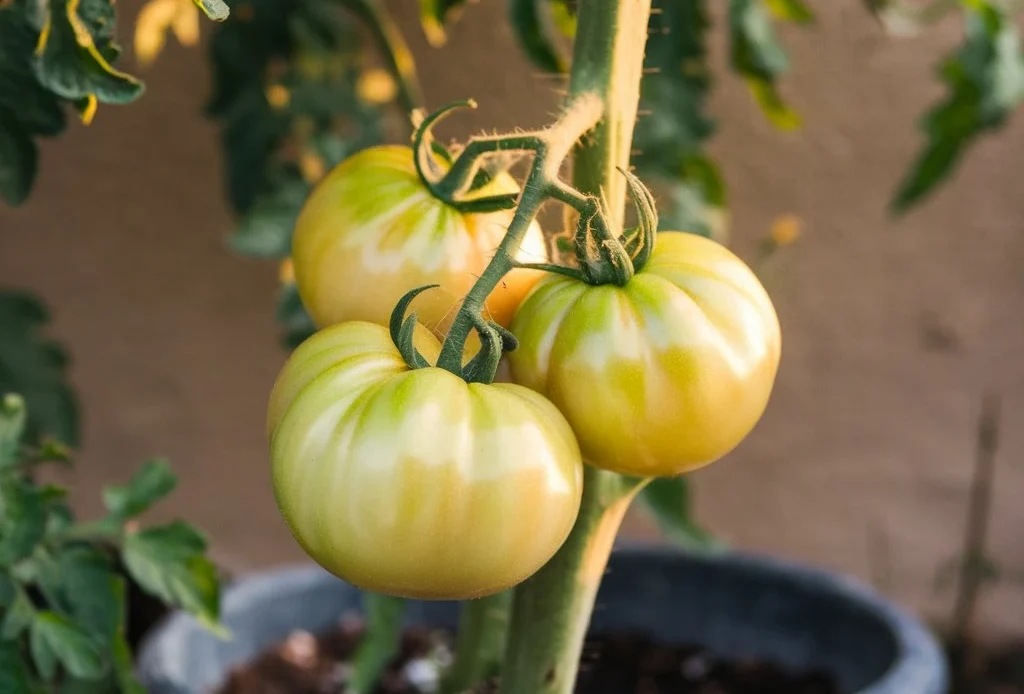
Ah, the bittersweet sight of a tomato plant bursting with flowers but stubbornly refusing to produce a single fruit. It’s like your plant is throwing a garden party but forgot to invite the tomatoes! Frustrating, right?
Before you give your plant a stern talking-to or threaten it with the compost bin, take a breath. There’s good news: this common gardening mystery has simple explanations—and even better solutions. From sneaky environmental stressors to pollination problems and nutrient missteps, we’ll uncover the culprits behind your tomato plant’s diva behavior.
Stick around, because we’re not just dishing out reasons—this guide is packed with actionable tips to turn those flirtatious flowers into plump, juicy tomatoes. Ready to unlock your plant’s potential? Let’s dig in!
Common Reasons Tomato Plants Fail to Produce Fruit
Tomato plants can be a little dramatic when their needs aren’t met. Picture this: your tomato plant is full of beautiful, blooming flowers, but somehow, not a single fruit in sight. It’s like a garden party without the snacks—so disappointing! But don’t fret. There are some common reasons your plant is throwing a tantrum, and luckily, each one has a fix. Here are the most likely causes behind your fruitless tomatoes:
Environmental Stress
Tomatoes are picky about their environment. They thrive best when everything is just right—not too hot, not too cold, and definitely not too humid or dry. If the conditions are off, your plants will respond by dropping flowers and refusing to fruit.
- Extreme Temperatures:
Tomatoes are sensitive to temperature extremes. When it gets too hot (above 85°F or 29°C) or too cold (below 55°F or 13°C), pollination becomes a struggle, and flowers can fall off prematurely. If temperatures stay out of their comfort zone for too long, your plant might just give up on producing fruit altogether. - Humidity Problems:
- Too High: Excess moisture in the air can cause pollen to clump together, making it ineffective for pollination. Essentially, your plant is ready to party, but no one can dance!
- Too Low: On the other hand, if the air is too dry, pollen dries out before it even has a chance to do its job. Low humidity leads to unproductive flowers and an unfruitful plant.
Pollination Issues
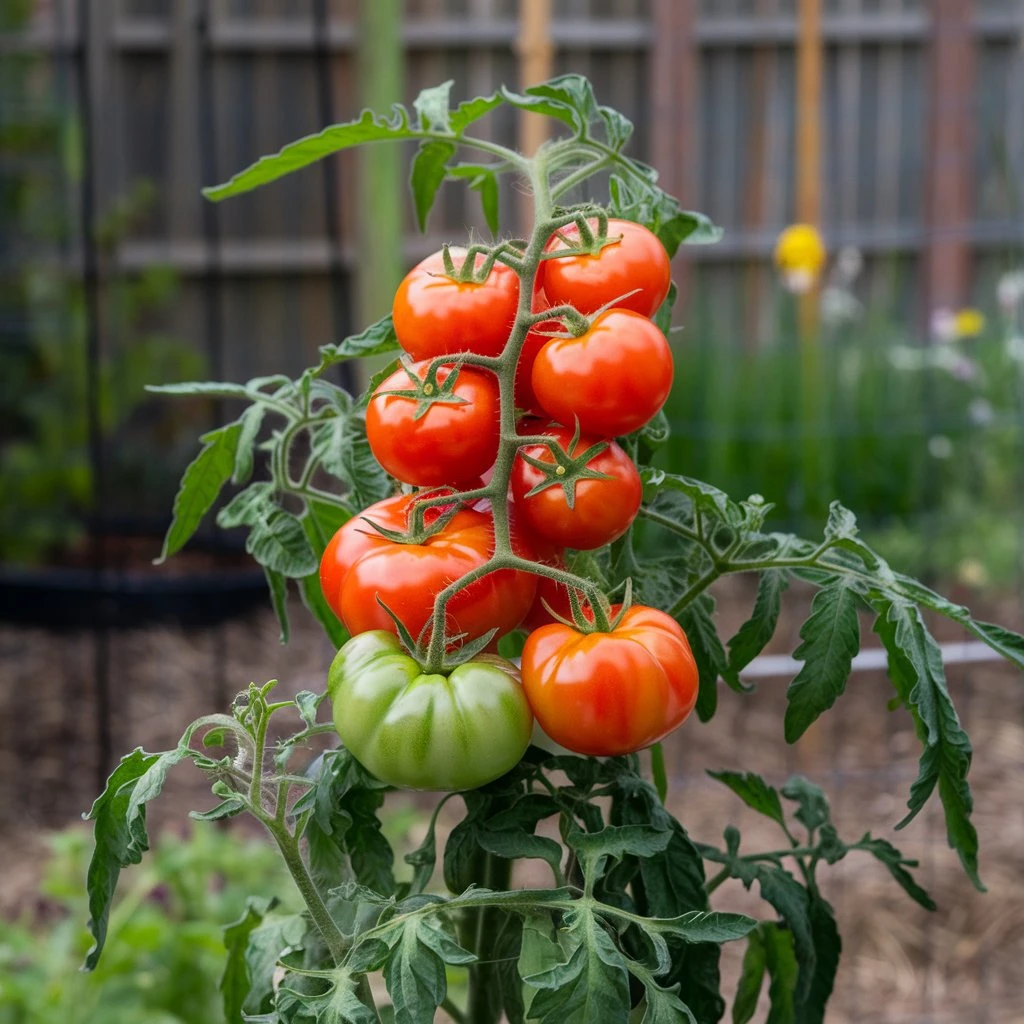
Without proper pollination, those pretty flowers will never turn into juicy tomatoes. Tomatoes rely on natural pollinators like bees, butterflies, or even a light breeze to move pollen from one flower to another. If the pollination process is disrupted, the flowers simply won’t develop into fruit.
- Poor Pollination:
If your garden is lacking natural pollinators or there’s no breeze to carry the pollen, your flowers will remain barren. This is a common issue in areas with low insect activity or where plants are in closed-off spaces. - Overcrowding:
Tomatoes need their space! If your plants are packed too tightly together, they won’t get proper airflow. Poor airflow leads to poor pollination opportunities, meaning your flowers have little chance of becoming fruit. Think of it as a crowded dance floor where no one can move—definitely not the vibe we’re going for
Nutritional Imbalances
Just like us, tomatoes need a balanced diet to thrive. If they’re not getting the right nutrients, they’ll focus on growing leaves and stems at the expense of flowers and fruit.
- Excess Nitrogen:
Nitrogen is great for promoting leafy green growth, but too much of it can lead to an explosion of foliage with no fruit to show for it. Think of it like inviting too many guests to the party—the plant will get busy growing all this lush greenery and forget that it’s supposed to be making tomatoes. - Insufficient Nutrients:
While nitrogen is important, your plant also needs other nutrients, like phosphorus and potassium, to develop strong roots, healthy flowers, and fruit. A lack of these key nutrients will stunt fruit production, even if your plant is otherwise healthy. Without these, flowers may form but fail to develop into the fruit you’re craving.
Inadequate Care
Sometimes, it’s the little things that matter most when caring for your tomato plant. If you aren’t meeting all their needs, they may throw in the towel and stop producing fruit altogether.
- Insufficient Sunlight:
Tomatoes are sun-worshippers, and they need 6–8 hours of full sunlight daily. Without enough light, the plant doesn’t have the energy to produce fruit. If your tomatoes aren’t getting enough sunshine, they may prioritize staying alive over making fruit. And who can blame them? They need their daily dose of rays to thrive. - Irregular Watering:
Tomato plants are pretty particular about their watering schedule. Inconsistent watering—whether overwatering or underwatering—puts the plant under stress. This can cause flowers to fall off prematurely, and your plant won’t have the energy to produce fruit. Regular, consistent watering is key to a thriving, fruiting tomato plant.
Pests and Diseases
Sometimes, your tomatoes are being sabotaged by some sneaky invaders. Pests and diseases can weaken plants, hinder pollination, or directly damage the flowers, preventing fruit production altogether.
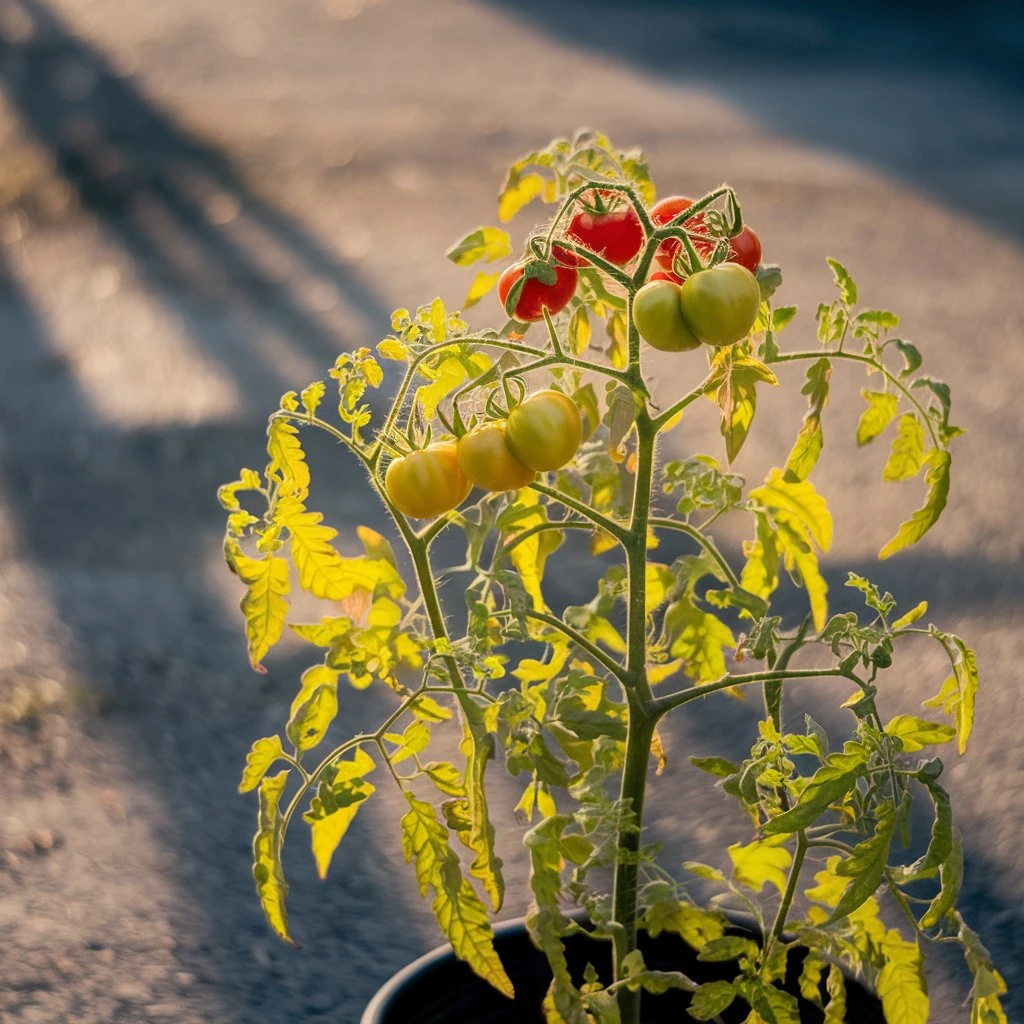
- Pests:
Aphids, thrips, and whiteflies are just a few of the insects that can damage your tomato plant. These pests suck the nutrients out of your plant, causing it to become stressed and unable to support fruit development. - Diseases:
Tomato plants are susceptible to various diseases, such as blight, wilt, and fungal infections. These diseases can cause flowers to drop off or prevent them from forming fruit. In severe cases, they can even kill the plant. Regularly check your plants for signs of disease, and treat them promptly if needed.
Wrapping It Up
No one likes a flower-only show—especially when you’ve been dreaming of juicy, homegrown tomatoes. But identifying the issues causing your plant to withhold its fruit is the first step to solving the problem. Whether it’s temperature stress, poor pollination, nutrient imbalances, care errors, or unwanted pests, addressing these common culprits can help turn your flower-filled tomato plant into a fruit-bearing powerhouse. Stay tuned for solutions, and soon enough, you’ll be harvesting the tomatoes of your dreams! 🌱🍅
How to Encourage Your Tomato Plants to Set Fruit
If you’ve found yourself staring at a tomato plant flowering but no fruit in sight, don’t panic! There are several ways you can encourage your tomato plants with flowers but no fruit to produce the tomatoes you’ve been eagerly waiting for. Here are the best practices to help turn those pretty flowers into tasty fruit. 🌱🍅
Managing Environmental Factors
Tomato plants are a bit picky when it comes to their surroundings. If your tomato plant has flowers but no fruit, environmental stress might be at the root of the problem. Here’s how to manage temperature extremes and humidity:
- Dealing with Extreme Heat, Cold, and Humidity:
Your tomato plant flowering but no fruit could be a result of the temperature being too hot or cold. If your region experiences extreme heat or sudden cold snaps, your plants might struggle to set fruit. To maintain stable conditions:- Use shade cloth during hot days to cool your plants and prevent overheating.
- If temperatures drop unexpectedly, mulching or using a greenhouse can help trap warmth around the plants.
- During excessive humidity, increase airflow to prevent pollen from clumping together and blocking pollination.
Supporting Pollination
If you’re dealing with flowers on tomato plants but no fruit, it could be due to poor pollination. Without proper pollen transfer, flowers won’t turn into fruit. Here’s how to give your tomatoes a hand in the pollination process:

- Hand-Pollination Techniques:
If natural pollinators like bees or wind aren’t doing their job, you can hand-pollinate your tomato plants flowering but no fruit. Simply use a small brush or cotton swab to transfer pollen from one flower to another. - Attracting Pollinators:
Bring in more bees and butterflies by planting pollinator-friendly flowers near your tomatoes. Flowers like marigolds and lavender will invite helpful insects to your garden. Proper plant spacing will also help—crowded plants limit airflow and make it harder for pollinators to reach each flower.
Balancing Soil Nutrients
A tomato plant with flowers but no fruit may also be struggling because the soil nutrients are out of balance. Tomato plants need specific nutrients to support both healthy growth and fruit production. Here’s how to get the soil just right:
- Using Fertilizers with Low Nitrogen and Adequate Phosphorus/Potassium:
If you’ve got a tomato plant flowering but no fruit, it could be because there’s too much nitrogen in the soil. While nitrogen promotes lush green growth, it can stunt fruiting. Opt for fertilizers with lower nitrogen and higher amounts of phosphorus and potassium to encourage fruit production. - Testing and Amending Soil for Optimal Growth:
Before jumping to conclusions, check the soil’s nutrient levels by performing a soil test. This will let you know exactly what’s missing. If necessary, amend the soil with compost, bone meal, or other organic matter to provide the missing nutrients, and watch your tomato plants flowering but no fruit start to change.
Improving Care
Sometimes, simple care tweaks can be all it takes to turn a tomato plant with flowers but no fruit into a productive, fruit-bearing beauty. Here’s how to improve the care routine:
- Ensuring 6–8 Hours of Sunlight Daily:
Tomatoes are sun-loving plants, so ensure your tomato plant has flowers but no fruit gets at least 6–8 hours of direct sunlight every day. If your plant is in a shady spot, it might focus on surviving rather than fruiting. If necessary, relocate your tomatoes to a sunnier spot or trim surrounding plants that are blocking the light. - Establishing a Consistent Watering Routine:
Inconsistent watering is a major stressor for tomato plants. It can lead to flower drop and poor fruit development. Set up a consistent watering schedule to keep your tomato plants hydrated but not waterlogged. Deep watering is better than frequent, shallow watering, as it helps the roots grow strong and supports healthy fruiting.
Preventing and Controlling Pests and Diseases
If your tomato plant flowering but no fruit is still not producing, it might be under attack from pests or diseases. Here’s how to protect your tomatoes:
- Identifying Common Pests and Control Solutions:
Pests like aphids, thrips, and whiteflies can weaken your plants, preventing them from producing fruit. These pests suck out vital nutrients, causing your plant stress. Treat infestations with organic pest control methods like neem oil or insecticidal soap, or use chemical solutions if necessary. - Steps to Prevent the Spread of Diseases:
Fungal and bacterial diseases like blight can kill flowers and stop fruit from forming. To prevent disease, practice crop rotation and always clean up plant debris at the end of the season. Avoid overhead watering to keep the leaves dry, and remove any diseased leaves immediately to prevent further spread.
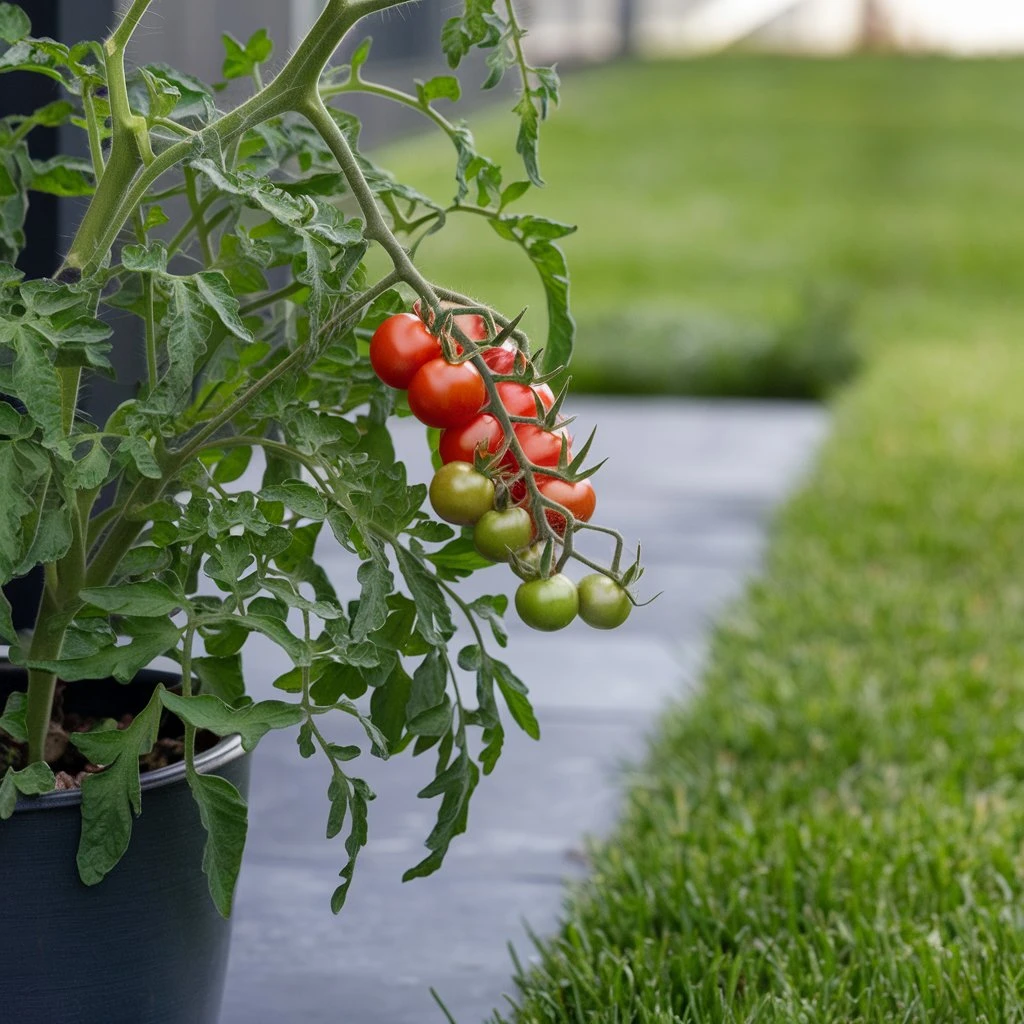
Wrapping It Up
With these tips, you’ll be able to encourage your tomato plant flowers but no fruit to set fruit and start producing tomatoes. By managing environmental factors, supporting pollination, balancing soil nutrients, improving care, and controlling pests and diseases, you’re giving your tomatoes the best chance for success. Stay patient and persistent, and soon you’ll be enjoying a bountiful harvest of juicy, homegrown tomatoes! 🌱🍅
Pro Tips to Prevent Blossom Drop and Maximize Tomato Harvest
If your tomato plants flowering but no fruit have you scratching your head, don’t worry—you’re not alone. There are a few key strategies you can adopt to prevent blossom drop and keep your tomato plant flowering but no fruit from being a recurring problem. Let’s dive into the best practices for long-term tomato care and maintenance, along with seasonal adjustments to ensure a consistent harvest.
Best Practices for Long-Term Tomato Care and Maintenance
- Provide Consistent Care Throughout the Season
Tomatoes are fairly low-maintenance once they have the right conditions, but maintaining that balance is key to preventing your tomato plant with flowers but no fruit from falling into a slump:- Regular Pruning: Regularly remove dead or diseased leaves and stems. This helps keep the plant healthy and improves airflow, preventing mildew and rot from setting in.
- Mulching: Mulch around the base of your tomato plants to retain moisture, suppress weeds, and regulate soil temperature. This reduces stress on the plant, which can help prevent flower drop.
- Water Deeply and Consistently
A tomato plant has flowers but no fruit may struggle if its watering routine is inconsistent. Deep watering is essential for robust root growth, which supports healthy fruit production. Avoid overhead watering, which can increase the likelihood of diseases like blight, and always water at the base of the plant. - Ensure Proper Plant Spacing
Overcrowded tomato plants lead to poor airflow, which affects both pollination and disease prevention. If your tomato plant flowers but no fruit and seems crowded, try spacing plants at least 18-24 inches apart. This will give each plant room to breathe and maximize its chances of successful pollination.
Seasonal Adjustments and Preventative Measures for Consistent Fruiting
- Temperature Management
Tomatoes are particularly sensitive to temperature extremes, so make seasonal adjustments as needed:- In the Spring/Summer: When temperatures soar above 85°F (29°C), use shade cloth to protect the plants from scorching heat and to prevent the flowers from dropping prematurely.
- In the Fall: If temperatures dip below 55°F (13°C), move your tomatoes to a warmer spot or use cloches or greenhouses to provide additional warmth, preventing the flowers from aborting due to cold stress.
- Monitor Humidity Levels
Humidity plays a huge role in whether your tomato plants flowering but no fruit can produce fruit. In the summer, high humidity can prevent pollen from traveling properly, while low humidity can dry out the flowers. Keep the air around your tomatoes balanced:- In High Humidity: Ensure there is adequate airflow by spacing plants properly and using fans in greenhouses or shaded areas to circulate the air.
- In Low Humidity: Increase moisture around your tomato plants by using a humidifier or misting the plants lightly.
- Fertilize Regularly with the Right Nutrients
Over-fertilizing with high-nitrogen fertilizers is a quick way to grow an abundance of leaves but very few tomatoes. Ensure you’re feeding your tomato plants with flowers but no fruit with a balanced fertilizer, one rich in phosphorus and potassium, to support flower-to-fruit conversion. - Be Proactive Against Pests and Diseases
Regularly inspect your tomato plant has flowers but no fruit for signs of pests or diseases. Aphids, whiteflies, and tomato hornworms are just a few culprits that can interfere with pollination and flower set. Combat these issues early by using organic pesticides, insecticidal soap, or neem oil.
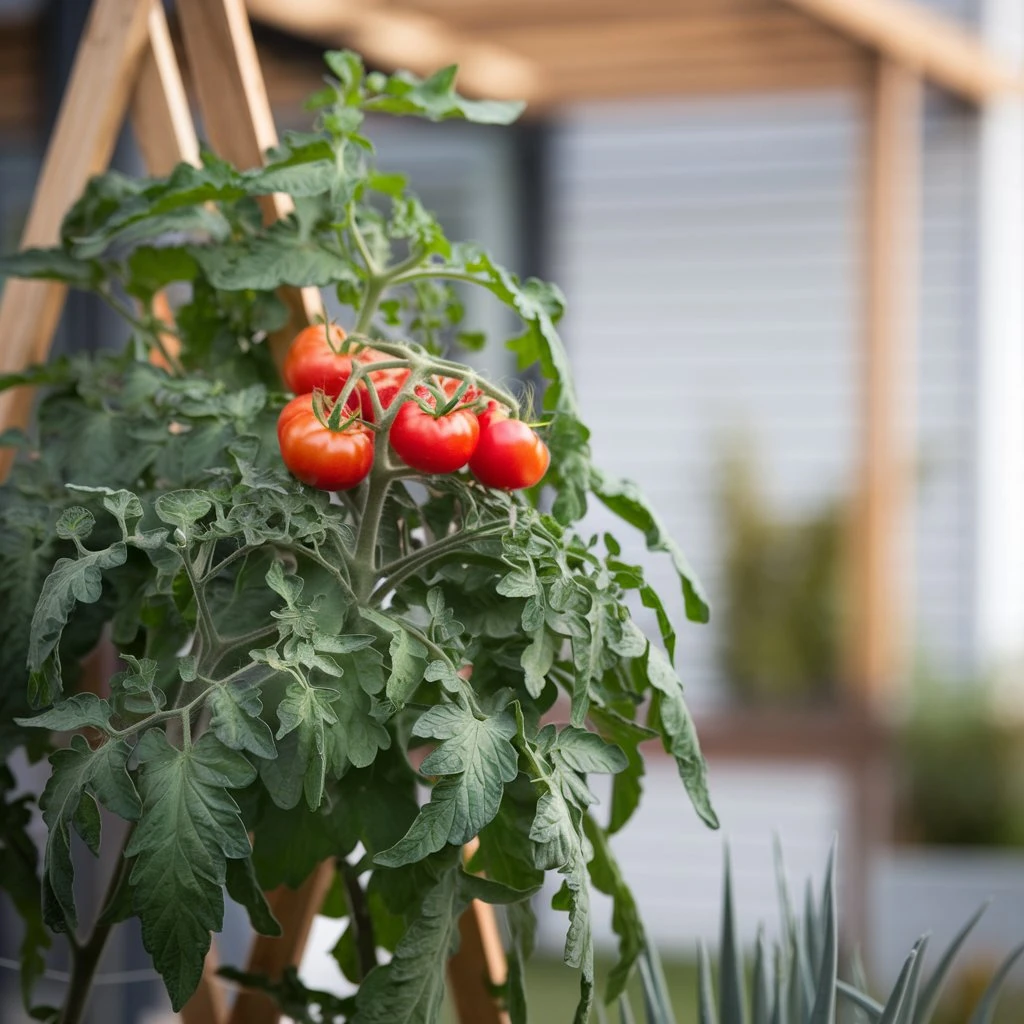
Keep Your Tomato Plants Thriving!
By implementing these pro tips, you’ll not only prevent blossom drop but also encourage a tomato plant flowering but no fruit to finally reach its full potential. Consistent care, environmental management, and proactive measures against pests and diseases will keep your plants healthy and productive throughout the growing season. Stay on top of these strategies, and soon your garden will be brimming with fresh, delicious tomatoes! 🌱🍅
FAQ
Why are my tomato plants blooming but not yielding fruit?
Tomato plants may bloom but fail to produce fruit due to poor pollination, extreme temperatures, or nutrient imbalances. Environmental stress, such as insufficient sunlight, excessive nitrogen, or high humidity, can also hinder fruit set. Ensuring optimal care and conditions can address these issues.
What can I do to help my tomato blossoms turn into fruit?
To help blossoms turn into fruit, ensure your plants receive proper pollination, either from insects or by hand-pollinating. Provide consistent water, avoid over-fertilizing with nitrogen, and protect plants from temperature extremes. Space plants adequately to improve airflow and reduce stress.
How can I promote fruiting in my tomato plants?
Promote fruiting by providing adequate sunlight (6-8 hours daily) and maintaining a consistent watering schedule. Use balanced fertilizers with lower nitrogen and ensure optimal temperatures for pollination. Also, remove any excess foliage that might block light or airflow.
How can I check if my tomato flowers have been pollinated?
You can tell if tomato flowers have been pollinated when the flower begins to wilt and the small green fruit starts to develop at the base. If the flower falls off without producing fruit, it likely hasn’t been successfully pollinated. Observing the presence of fruit development is a clear indicator.
Is fertilizing necessary for tomatoes when they are flowering?
Fertilizing during the flowering stage can be beneficial, but it should be done with caution. Use a fertilizer low in nitrogen but rich in phosphorus and potassium to support flower-to-fruit conversion. Avoid over-fertilizing, as excess nitrogen can encourage foliage growth at the expense of fruit.
What’s the ideal watering frequency for tomato plants?
Tomato plants require consistent watering, ideally 1-2 inches of water per week, depending on weather conditions. Water deeply at the base of the plant to encourage strong root development and reduce the risk of disease. Avoid frequent shallow watering to prevent root rot and stress.
Conclusion
In conclusion, if your tomato plants are blooming but not producing fruit, it’s usually a sign that something in their environment, care, or pollination needs a little adjustment. By addressing key factors like temperature, sunlight, watering, and pollination, you can turn those beautiful flowers into delicious, ripe tomatoes. With the tips and strategies shared here, you’re now equipped to nurture your tomato plants into thriving, fruitful harvests. Happy gardening, and may your next tomato crop be bountiful! 🌿🍅
Check out our latest article for more insights, and follow us on Facebook for updates! and connect with us on Instagram, Pinterest, and YouTube for more inspiration!
By: Mark


